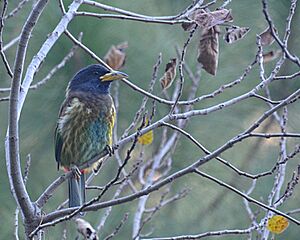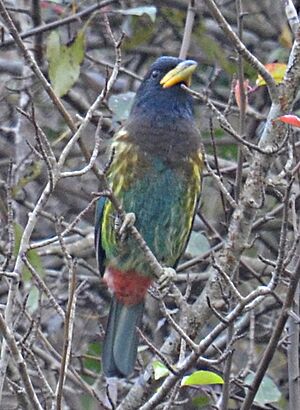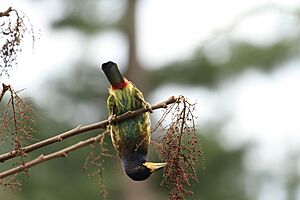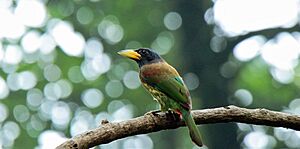Great barbet facts for kids
Quick facts for kids Great barbet |
|
|---|---|
 |
|
| A great barbet in Godawari, Lalitpur | |
| Conservation status | |
| Scientific classification | |
| Genus: |
Psilopogon
|
| Species: |
virens
|
The great barbet (Psilopogon virens) is a colorful bird found in Asia. It lives in forests across the Indian sub-continent and Southeast Asia. You can find these birds in high places, sometimes up to 3,000 meters (about 9,800 feet) above sea level! Scientists have listed it as "Least Concern" since 2004. This means there are still lots of great barbets around, and they are not in danger of disappearing.
About the Great Barbet

The great barbet is a really striking bird. It has a bright blue head and a big, yellow beak. Its body is a mix of brown and green streaks, and it has a red patch under its tail. The rest of its feathers are mostly green, helping it blend in with the trees.
This bird is the largest type of barbet. It can be about 32 to 35 centimeters (12 to 14 inches) long. That's about the length of a school ruler! It usually weighs between 192 and 295 grams (about 6.8 to 10.4 ounces).
Where Great Barbets Live
Great barbets live in many parts of Asia. They are often found in the lower and middle parts of the Himalayas mountains. This includes countries like northern Pakistan, India, Nepal, and Bhutan. You can also find them in Bangladesh and parts of Southeast Asia, like Laos. They like to stay in one area and don't usually migrate.
Life and Habits
Great barbets are busy birds, especially during their nesting season. This usually happens from April to July. Like many birds, they build their nests inside holes in trees. Both the male and female great barbets work together to take care of their young.
Their diet is a mix of different things. They love to eat fruits, but they also enjoy munching on insects.
These birds are quite noisy! The male great barbet has a very loud call that sounds like kay-oh. If they sense danger, they make a harsh keeab sound to warn others. They also have another call that sounds like a repeated piou-piou-piou-piou.
How Scientists Name Birds
Scientists give every animal a special two-part name, called a scientific name. This helps everyone around the world know exactly which animal they are talking about. For the great barbet, its scientific name is Psilopogon virens.
A long time ago, in 1783, a scientist named Pieter Boddaert gave this bird its first scientific name, Bucco virens. He based his description on a bird from China. Later, in 1842, another scientist, George Robert Gray, suggested using the name Megalaima instead of Bucco.
Over the years, scientists found slightly different great barbets in different places. They gave these birds special names too, like:
- Megalaema marshallorum from the Himalayas (named in 1870).
- Megalaima virens magnifica from Machi, Manipur (named in 1926).
- Megalaima virens clamator from northern Myanmar (named in 1941).
More recently, scientists used something called "molecular phylogenetic research." This is like using DNA tests to see how closely different animals are related. They found that all the birds in the Megalaima group were very similar to a bird called the fire-tufted barbet, which was in a group called Psilopogon. Because Psilopogon was the older name, all these barbets, including the great barbet, were moved into the Psilopogon group.
Today, scientists recognize four main types, or subspecies, of the great barbet:
- P. v. virens: Found in central Myanmar, Thailand, Vietnam, and China.
- P. v. marshallorum: Lives from northeastern Pakistan to western Nepal.
- P. v. magnificus: Found from eastern Nepal to Assam.
- P. v. clamator: Lives from Assam and northern Myanmar to northern Thailand and Yunnan in China.
Scientists also found that the great barbet is most closely related to the red-vented barbet (P. lagrandieri). This bird lives in Cambodia, Laos, and Vietnam.





